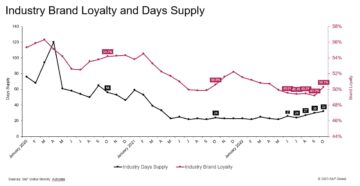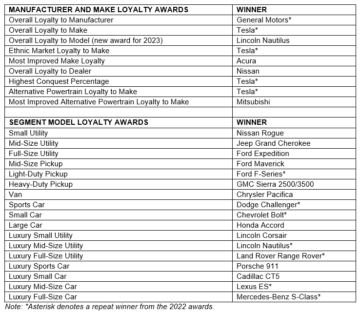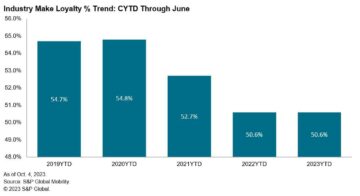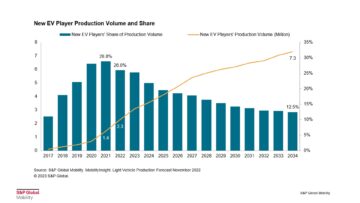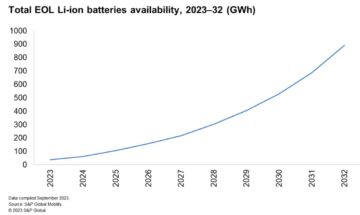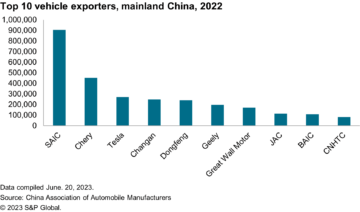With more than one-third of used vehicle loans in 2023
carrying loan-to-value ratios above 130%, used vehicle LTVs are at
historic highs. Have lenders (and consumers) taken on too much
risk?
As the transaction prices of used vehicles steadily rose through
the pandemic, the corresponding funding needs of consumers who
purchase those vehicles also have increased. But so has the risk
that lenders must consider when deciding to finance their
customers’ vehicle purchases, according to analysis of data from
AutoCreditInsight by TransUnion and S&P Global Mobility.
The key metric in new- and used-car financing is the
loan-to-value (LTV) ratio. LTV weighs the value of the vehicle as
collateral for the loan and the amount of risk the lender is
willing to take to originate the auto loan. And while used vehicle
prices soared and mostly held firm, their underlying values as
assets have not necessarily kept pace. What remains to be seen is
how used vehicle values will decline or hold steady with new
vehicle inventory, incentives, and demand.
From the start of 2022 through Q1 2023, the average LTV on used
vehicles climbed sharply to 125 percent, an increase of 15
percentage points, according to TransUnion and S&P Global
Mobility AutoCreditInsight. In the second quarter of 2023, that
percentage eased slightly, to 123%.
What’s more, 40% of used vehicle loans in Q1 2023 originated
with a starting LTV of 130% or higher, compared to only 22% hitting
that level in Q1 2019. In Q2 2023, that percentage also eased
slightly, to 36%, but those are still near historic highs.
In other words, lenders are loaning amounts of money far higher
than the financed used vehicles are actually worth – at interest
rates far higher than they were two years ago. Could this weigh
down the whole portfolio, or is it just a blip?
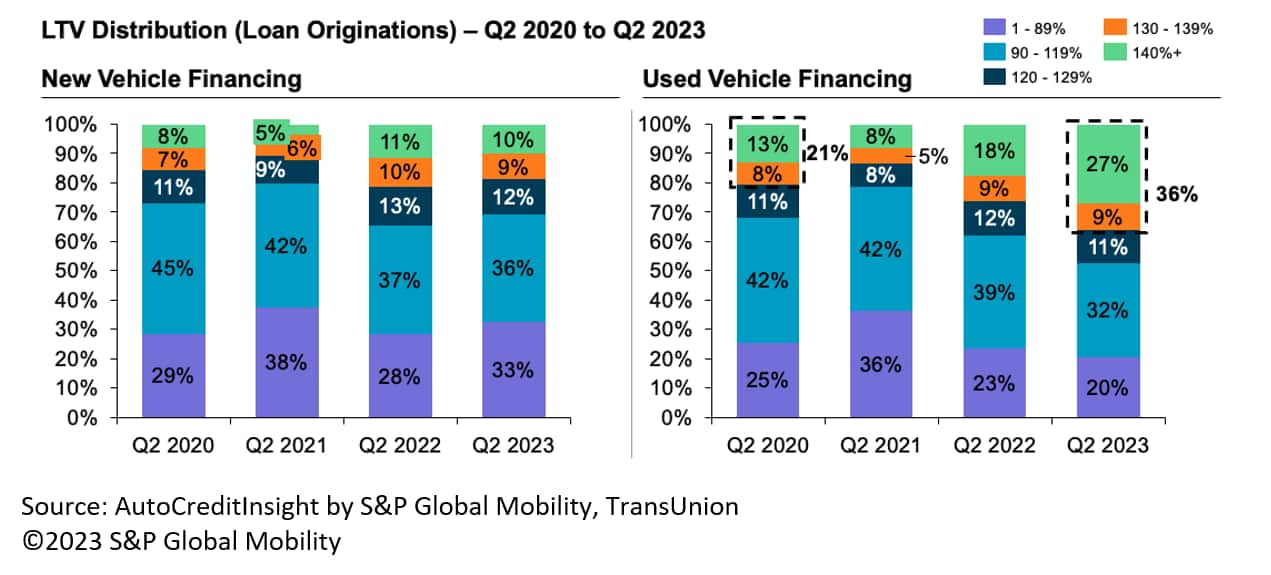
Why is this number worth watching?
“While consumers are broadly still doing well due to low
unemployment, recent trends of higher originating LTV’s combined
with higher vehicle prices and the possibility for quicker
depreciation as vehicle values stabilize creates a pocket of
elevated risk in some auto portfolios,” said Satyan Merchant,
senior vice president and automotive business leader for
TransUnion.
“That said, with the exception of this recent pocket of higher
LTV originations, the overall portfolio is well collateralized,”
Merchant added.
By contrast, new vehicle LTVs jumped slightly in 2021 and then
held steady in 2022, before declining for the two latest quarters,
almost back to pre-pandemic levels, according to AutoCreditInsight
by TransUnion and S&P Global Mobility.

“Used vehicles’ value skyrocketed during the pandemic due to the
inventory constraints of new vehicles from supply chain and
production issues,” said Jill Louden, associate director for
AutoCreditInsight at S&P Global Mobility. “However, auction
indices we’ve seen are starting to level out following huge spikes
of year-over-year growth in used vehicle pricing.”
Auctions and dealers want used vehicles because they know they
can sell them for an elevated price based on demand and scarcity
for these products, Louden added. A new twist: Recent-model used
vehicles are going to be challenged again, as leasing cratered with
the initial stage of the pandemic three years ago and as a result,
fewer vehicles are coming off lease and available in the
market.”
“When consumers cannot buy new, due to lack of availability or
pricing, then they are forced to buy used,” Louden said. “But when
there is a lack of availability of near-new used vehicles, the
pricing pressure works its way through the entire resale
chain.”
Although there has been a lack of new-vehicle incentives from
OEMs who have not needed to discount sticker prices, that is
starting to turn, as new-vehicle inventories have been rising on
many vehicles.
But effectively canceling any cash incentives – according to
TransUnion – has been the Fed’s attempt to tame inflation with a
series of 11 rate hikes from March 2022 through August 2023.
Since the Fed began raising rates, average auto loan APRs have
increased from Q4 2021 levels for new vehicles at 3.86% and used
vehicles at 8.28%, up to Q2 2023 levels of 6.85% for new, and
11.87% for used, Merchant said.
These combined factors have pushed up vehicle payments, while
carrying a LTV nearly 15 percentage points higher, and for a longer
term. All of this adds risk – for lenders and consumers alike.
The monthly payment increase isn’t as large for used vehicles
during this period because used prices started to retreat from
their peaks,” Merchant said. “But despite the used price declines,
monthly payment still went up due to rate increases. New vehicles
had both price and APR increases to contend with.”
Here’s the math
According to S&P Global Mobility and TransUnion data, the
average monthly loan payment for a used vehicle in Q1 2019 was
approximately $390 with an LTV of 110% and an average monthly loan
term of 63.6 months.
However, March 2020 marked the pandemic’s start and ensuing
havoc on regional and global economies.
By 1Q 2021, soaring used vehicle values meant the average
monthly payment for a used vehicle surged to almost $414; but the
LTV dropped to 104% — due to customers having higher down
payments due to COVID-19 relief money and higher trade-in values
due to used vehicle scarcity. Also, the average term jumped to 65.1
months.
In 1Q 2022, however, the full effect of the pandemic began to
take shape with respect to the car-buying public. Used vehicle
values continued to climb. As a result, used vehicles saw the
average monthly payment jump by nearly $100 to $508, the LTV
increase to 110% and the average term showing a modest increase to
67.2 months.
Then conditions became dramatic. Through 2Q 2023, TransUnion
data show that the average monthly payment for a used car jumped to
$533 while the LTV was 123%. These levels are stratospherically
high, although the LTV has retreated slightly from 125% in 1Q
2023.
“An average monthly vehicle payment of more than $530 for used
vehicles is a big chunk out of the household monthly income, and we
see these challenges on monthly payments continuing for now,”
Louden noted.
“On the plus side, new vehicle inventories have returned on many
vehicles, which will help dealers get back more traditional retail
sales models and increase competition among OEMs – causing
incentives to return to the new vehicle market and reducing
pressure on the used vehicle side,” Louden added.
“Things right now are leveling out on the new side, and used
prices are slowly coming down,” Louden said. “But compared to
pre-pandemic, it’s still not a consumer-friendly market.”
CONSUMER LOYALTY TO FINANCE COMPANIES FELL SHARPLY DURING
PANDEMIC
AUTO-FINANCE DELINQUENCIES RISE PAST GREAT RECESSION PEAK,
BUT…
SUBSCRIBE TO AUTOCREDITINSIGHT
LOWER-CREDIT BUYERS PUSHED OUT OF NEW
VEHICLES
THE AUTO INDUSTRY SHARE WARS WILL RESUME IN ’23
SEPTEMBER AUTO INDUSTRY TRENDS
SUBSCRIBE TO OUR TOP 10 INDUSTRY TRENDS
NEWSLETTER
This article was published by S&P Global Mobility and not by S&P Global Ratings, which is a separately managed division of S&P Global.
- SEO Powered Content & PR Distribution. Get Amplified Today.
- PlatoData.Network Vertical Generative Ai. Empower Yourself. Access Here.
- PlatoAiStream. Web3 Intelligence. Knowledge Amplified. Access Here.
- PlatoESG. Carbon, CleanTech, Energy, Environment, Solar, Waste Management. Access Here.
- PlatoHealth. Biotech and Clinical Trials Intelligence. Access Here.
- Source: http://www.spglobal.com/mobility/en/research-analysis/have-lenders-and-consumers-taken-on-too-much-risk.html
- :has
- :is
- :not
- ][p
- $UP
- 1
- 10
- 11
- 125
- 15%
- 2019
- 2020
- 2021
- 2022
- 2023
- 385
- 400
- 65
- 67
- 8
- a
- above
- According
- actually
- added
- Adds
- again
- ago
- alike
- All
- almost
- also
- Although
- among
- amount
- amounts
- an
- analysis
- and
- any
- approximately
- apr
- ARE
- article
- AS
- Assets
- Associate
- At
- attempt
- Auction
- AUGUST
- auto
- automotive
- availability
- available
- average
- back
- based
- BE
- became
- because
- been
- before
- began
- Big
- both
- broadly
- business
- but
- buy
- buyers
- by
- CAN
- cannot
- car
- carrying
- Cash
- causing
- chain
- challenged
- challenges
- climb
- Climbed
- Collateral
- collateralized
- combined
- coming
- Companies
- compared
- competition
- conditions
- Consider
- constraints
- Consumers
- continued
- continuing
- contrast
- Corresponding
- could
- COVID-19
- creates
- Customers
- data
- dealers
- Deciding
- Decline
- Declines
- Declining
- Demand
- depreciation
- Despite
- Director
- Discount
- Division
- doing
- down
- dramatic
- dropped
- due
- during
- economies
- effect
- effectively
- elevated
- Entire
- Ether (ETH)
- exception
- factors
- far
- Fed
- fewer
- finance
- financed
- financing
- Firm
- following
- For
- forced
- from
- full
- funding
- get
- Global
- going
- great
- Growth
- had
- Have
- having
- Held
- help
- High
- higher
- Highs
- Hikes
- historic
- hitting
- hold
- household
- How
- However
- HTML
- HTTPS
- huge
- in
- Incentives
- Income
- Increase
- increased
- Increases
- Indices
- industry
- inflation
- initial
- interest
- inventory
- isn
- issues
- IT
- ITS
- jump
- just
- kept
- Key
- Know
- Lack
- large
- latest
- leader
- leasing
- lender
- lenders
- Level
- levels
- loan
- Loans
- longer
- Low
- Loyalty
- LTV
- managed
- many
- March
- march 2020
- marked
- Market
- meant
- Merchant
- metric
- mobility
- models
- modest
- money
- monthly
- months
- more
- mostly
- much
- must
- Near
- nearly
- necessarily
- needed
- needs
- New
- noted
- now
- number
- of
- off
- on
- One-third
- only
- or
- originated
- originating
- originations
- Other
- our
- out
- overall
- Pace
- pandemic
- past
- payment
- payments
- Peak
- percent
- percentage
- period
- plato
- Plato Data Intelligence
- PlatoData
- plus
- points
- portfolio
- portfolios
- possibility
- president
- pressure
- price
- Prices
- pricing
- Production
- Products
- public
- published
- purchase
- purchases
- pushed
- Q1
- Q2
- Quarter
- quicker
- raising
- Rate
- rate hikes
- Rates
- ratings
- ratio
- ratios
- recent
- recession
- reducing
- regional
- relief
- remains
- respect
- result
- resume
- retail
- Retreat
- return
- right
- Rise
- rising
- Risk
- ROSE
- s
- S&P
- S&P Global
- Said
- sales
- saw
- Scarcity
- Second
- second quarter
- see
- seen
- sell
- senior
- separately
- Series
- Shape
- Share
- show
- showing
- side
- Slowly
- So
- soared
- soaring
- some
- spikes
- stabilize
- Stage
- start
- started
- Starting
- steady
- Still
- supply
- supply chain
- Surged
- T
- Take
- taken
- term
- than
- that
- The
- the Fed
- their
- Them
- then
- There.
- These
- they
- things
- this
- those
- three
- Through
- to
- too
- top
- Top 10
- trade-in
- traditional
- transaction
- Transunion
- Trends
- TURN
- twist
- two
- underlying
- unemployment
- used
- value
- Values
- Ve
- vehicle
- Vehicles
- vice
- Vice President
- want
- was
- watching
- Way..
- we
- weigh
- weighs
- WELL
- went
- were
- What
- when
- which
- while
- WHO
- whole
- will
- willing
- with
- words
- works
- worth
- years
- zephyrnet



